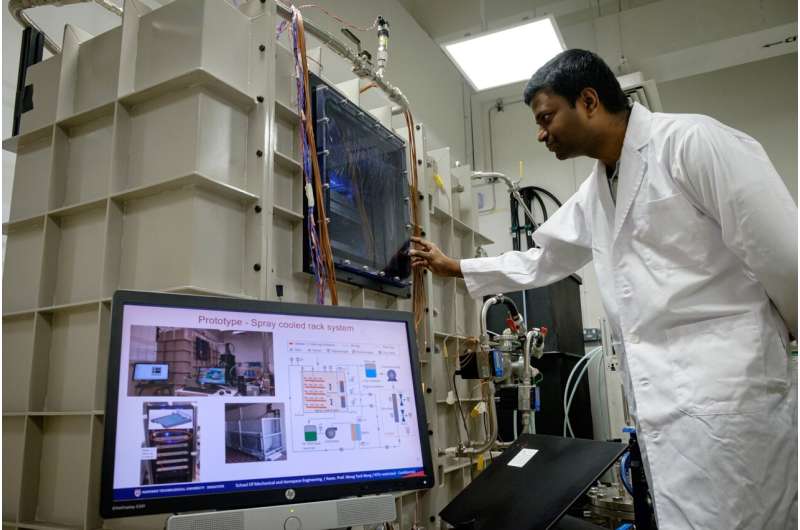This article has been reviewed according to Science X's editorial process and policies. Editors have highlighted the following attributes while ensuring the content's credibility:
fact-checked
trusted source
proofread
Scientists invent spray cooling to lower carbon footprint of data centers

Scientists from Nanyang Technological University, Singapore (NTU Singapore) have invented a more sustainable and green method for cooling down servers in data centers, potentially reducing up to 26% in both energy costs and carbon footprint.
Currently, data centers in Singapore account for 7% of the nation's total electricity consumption. With the demand for cloud computing increasing, it is critical to find a sustainable solution that reduces energy consumption and the carbon footprint of data centers.
In a data center, the hottest component in a server is the CPU—central processing unit—which requires a dedicated air-cooled heatsink for heat dissipation.
When servers are stacked together in a rack vertically, they produce a substantial amount of heat, so cold air is required to be drawn in to cool the server, after which, the hot air is expelled to the surroundings. This air-cooling method is the reason why data centers have to run on energy-intensive air-conditioning systems to lower air temperatures.
In comparison, this new method developed by NTU scientists uses a special spray of non-conductive fluids to cool the CPU directly without a heatsink, utilizing a combination of highly efficient heat removal mechanisms such as evaporation and boiling.
The gases and excess fluids are then collected in an enclosed system, condensed into liquid at tropical ambient temperatures (around 30 degrees Celsius) and recirculated back into the system for reuse.
More importantly, spray cooling has the potential to carry away more heat than air cooling, which will allow for CPUs to run faster and perform better than today's speeds which are limited by air cooling since faster speeds will lead to higher temperatures.
Based on the power consumed by the servers in a rack (known as rack density), the resulting waste heat generated is estimated to be around 7kW per cubic meter in conventional air-cooled racks. In comparison, the spray-cooling prototype has shown to be able to dissipate significantly more heat, and capable of handling rack densities as high as 23kW per cubic meter.
If spray cooling is adopted industrially, it can allow for higher computing power servers to be packed into a smaller space than current data centers. The team estimates that it could translate into space savings of 30% when compared to conventional data centers that use air-cooling systems, a significant advantage for land-scarce countries like Singapore.
Leader of the project, Associate Professor Wong Teck Neng from NTU's School of Mechanical and Aerospace Engineering, says the main benefits of their new method are its high energy efficiency and targeted approach.
"Instead of cooling the entire data center conventionally, we designed special sprays to aim directly at the CPU, the critical component which is the key source of heat in a data center," says Assoc Prof Wong, who is also the Assistant Chair (Faculty) at the school.
"The inspiration for our innovation is simple. If there is a fire breaking out on a piece of wood, we are taught to point the fire extinguisher at the base of the fire to put it out, not spray at the flames or around the fire to cool it down, since the fire will continue to burn at the source. Similarly, why are we spending an immense amount of energy cooling down the air around the heat source, when we should be cooling it directly?"
Assoc Prof Wong explained that their targeted approach is a smarter approach, especially in tropical environments, where the high humidity and heat can put a significant strain on traditional air-cooling systems. For instance, a conventional data center has to be cooled down to about 18 degrees Celsius, which accounts for about 40% of its total energy usage.
In contrast, using spray cooling, CPUs can maintain their optimal temperature at about 55 degrees Celsius without the need for energy-intensive air-conditioning units. Power usage effectiveness (PUE)—the ratio of the total amount of power used by the data center versus the actual power delivered to the servers—of the new prototype can go as low as 1.08. This can result in significant savings in cooling energy when compared to traditional air-cooled data centers which are usually at 1.8 PUE.
Studies by the team also showed that based on a data center IT load of 1 megawatt, their spray-cooled system could save up to 1550 tons of CO2 emission annually when compared to conventional air-cooling systems.
This will be a significant reduction in carbon footprint, given that most data centers consume 1000 kWh per meter square. Energy-efficient operation of a spray-cooled data center can also lead to 26% savings in annual energy costs.
It can also pave the way for faster and more efficient data centers in future, as demand for cloud computing continues to raise annually by some 15%.
A spokesperson from AFTERSHOCK PC, which is Singapore's largest high-performance custom personal computer builder and is collaborating with Assoc Prof Wong on another sustainability project, said that "spray cooling technology offers superior cooling capability, and this certainly helps to unlock full potential of computing chips and graphics card currently in market by overclocking beyond its normal operating range. This directly leads to the future and potential of seamless computing and video rendering performance for our high-performance computers."
The prototype system consists of an enclosed spray-cooled server rack capable of operating near atmospheric pressure, a water pump, sprays with multiple nozzles over each CPU, a collection system to collect the vapourised liquid, and an energy-efficient room-temperature condenser to convert the gases back into liquid again. Unlike conventional air-conditioning systems, no chiller system is required.















